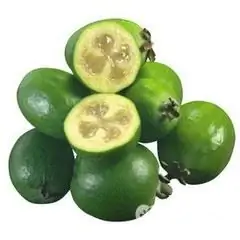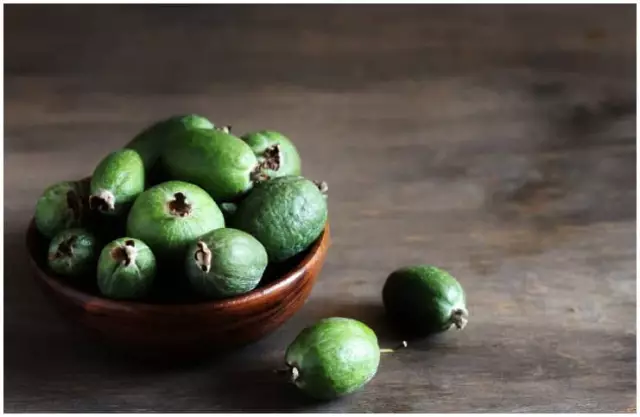- Author Rachel Wainwright [email protected].
- Public 2023-12-15 07:39.
- Last modified 2025-11-02 20:14.
What is the use of feijoa?

Feijoa, an exotic plant with an unusual name and taste, is truly a storehouse of nutrients. Most often, speaking about this berry, they mention a high iodine content. Iodine is one of the minerals vital for the body's functioning, in particular for the functioning of the thyroid gland. The amount of iodine in feijoa can vary significantly, from 8 to 35mg / 100g, it depends on the area in which the plant grows, but even the poorest iodine fruits of feijoa contain much more of it than any other vegetables or fruits, except, perhaps, only seaweed. The daily requirement for iodine in an adult is only 0.15-0.20 mg. Therefore, the benefits of feijoa for people with one form or another of iodine deficiency can hardly be overestimated.
But the benefits of feijoa are not limited to just one high iodine content. These large green berries also contain vitamin C, which is probably unnecessary to talk about. Vitamin C helps in the prevention and treatment of colds, and therefore in November, when feijoa hits the shelves of our stores, this delicacy is especially important, because this time of the year falls on the peak of seasonal epidemics of colds.
Feijoa pulp is rich in pectins, flavonoids, vitamins and minerals. In addition to those listed above, potassium, iron, vitamins B and P, folic acid, and essential oils that have anti-inflammatory activity are present here. All this determines the great benefits of feijoa and its important role in dietary nutrition. Due to this composition, the fruits of this plant have a therapeutic effect in diseases of the gastrointestinal tract, kidneys, cardiovascular system and metabolic disorders. In addition, feijoa stimulates the body's defenses.
Usually, when eaten, the pulp of the fruit is used and the peel is discarded. Meanwhile, feijoa peel is a very valuable source of antioxidants, substances that prevent the formation of free radicals, which are the main cause of aging and the appearance of malignant tumors. Since the taste of the peel is not particularly attractive compared to the juicy and aromatic pulp, experts recommend drying it and adding it to tea or making an infusion from it, so that the benefits of feijoa are maximized.
And of course, one cannot fail to note the value of this plant for cooking. Feijoa can be eaten in almost any form - raw, boiled, stewed, grated with sugar. Jams, delicious desserts, and sauces for meat are made from it. It would seem, what else can be useful? But that's not all. Feijoa is a beautiful evergreen shrub, and in our climate it is used for interior decoration as a houseplant.
Found a mistake in the text? Select it and press Ctrl + Enter.






